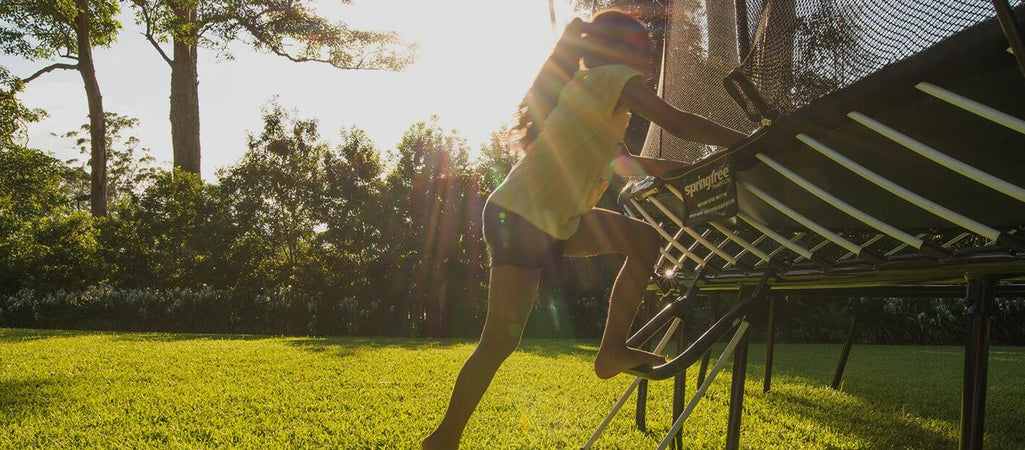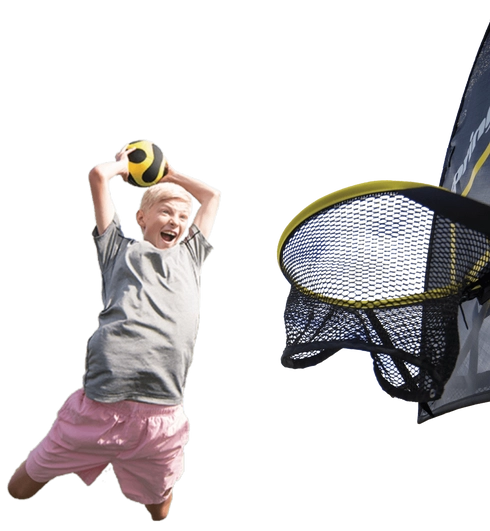Your Guide To Buying A Safe Trampoline
min read

If you’re considering a trampoline for your family, this buyer’s guide is the perfect place to start.
With so many different models available ranging from (very) cheap to premium quality, choosing the right trampoline can be tricky.
If you, like many others, remember trampolines with fondness you’ll want to recreate that same sense of fun and adventure for your kids as they grow up. However you may also remember that the enthusiasm for trampolining often came with a string of injuries you would rather avoid with your child.
So how can you be sure the model you choose will be the best option for your family, keeping the kids safe and happy and encouraging them to develop their confidence, fitness and enjoy the outdoors as much as possible?
Here are some important considerations before you buy.
1. Do Your Trampoline Research
Research is every careful buyer’s best friend. In Australia, trampoline standards are currently only voluntary, so make sure you’re well informed before you purchase.
For 70 years the traditional trampoline remained largely unchanged in design until the early 2000’s when an engineer started to look at how to improve the safety rating of our favourite piece of backyard equipment.
Efforts have been made to make the traditional trampoline safer and now all trampolines sold in Australia must come with pads over the springs and an enclosure net. But do these features make traditional trampolines safe, or are you better to consider one of the new revolutionary designs? Springfree Trampoline's revolutionary design removed all the impact areas that cause 90% of product-related trampoline injury.
2. Pads
Safety pads to cover the springs were one of the first additions to the traditional trampoline. The pads, made from foam, either Velcro or tie to the steel frame of the trampoline and are supposed to offer protection from the springs and hard frame. However, the pads move around and rapidly deteriorate in the elements, offering minimal protection to the jumper. With the shortest lifespan of any part of a trampoline, the safest choice would be to consider a design that doesn’t rely on this flimsy layer of protection to keep your kids safe.
There are a couple of trampolines on the market that don’t require pads because they boast a soft edge. That is, the frame and spring system are below the jumping surface. This seems like a great option. There’s no need to worry about how to reattach or replace deteriorated pads – the need for them has been removed altogether. Springfree Trampoline is the World's Safest Trampoline, and its patented design has removed all the impact points that cause 90% of product-related trampoline injuries. With no springs, the frame well away from the jumping surface and no hard surfaces to come into contact with.
3. Springs
The springs are the most obvious design change between the traditional trampoline and Springfree models. In 2012 consumer watchdog Choice reviewed 12 popular trampoline models sold in Australia and part of their findings were that springs could cause entrapment and, even worse, strangulation. That’s pretty serious stuff from a piece of play equipment! Aside from these extreme injuries, the springs are responsible for pinching, bruising and trapping little legs that fall between them. Again, this is another design feature best avoided by considering a Springfree model. Springfree Trampoline was in fact the top reccommendation by Choice.
4. Net
All trampolines now come with an enclosure but often, the net provides little more than a visual barrier. Low quality nets deteriorate so rapidly in our Australian conditions and a couple of wayward jumpers is all it takes for the net to tear and be rendered useless. Take a look at trampolines around your local neighbourhood. How do the nets look? More often than not they’re torn, sagging and perished. Before you purchase, investigate what the net is made of and how is it UV treated. Some nets are similar to fly screens and will easily tear while others are made from a weave that consists of individual knots that mean the net can’t tear and it is flexible.
While most manufacturers will provide the net as a spare part for sale, it’s worthwhile checking if the net and mat are separate parts or if they are one piece, sewn together. You don’t want to have to waste money purchasing a net and mat due to a flawed design.
5. Net Poles
While you’re looking at the net, check out what’s holding it up. Is it rigid steel poles, which actually present another hazard to the jumper? If the jumper was to hit the net where a pole is, are they able to make contact with that pole? A bit of pool-noodle-style foam is not going to offer much protection to a head travelling at speed towards that pole either. This is where a flexible style pole that moves with the enclosure is the best bet for safety. When you’re checking the trampoline out, give the poles that hold the net up a shake. Do they feel strong and sturdy or lightweight? Remember this feature, along with the net, is supposed to hold the weight of a jumper and be the alternative to hitting the ground at speed. Ideally you’re looking for an enclosure that is strong, flexible and will move with the jumper and redirect them safely back to the middle of the mat, like Springfree Trampoline's flexible net poles.
6. The Frame
The final design feature to check out is the frame. Firstly, is it strong and heavy duty? And is the frame largely “seamless” or are the joins clunky and obvious with sharp edges that could offer a nasty encounter. The second thing to check is where the frame is. Due to some savvy design work, it is possible to own a trampoline where the hard steel frame is well out of the way of the jumping surface and there’s no possible way the jumper can contact it. Look for a frame that sits below the jumping surface.
So here’s your safe trampoline checklist:
1. No springs! Yes – this is possible, even though the product you’re purchasing needs something to make it bouncy!
2. No pads – look for a design that doesn’t have springs or a frame that need covering up. The feature to look for is known as “SoftEdge™ technology.”
3. A strong but flexible enclosure – check for a high quality net that will last, that is held up by flexible poles that can’t be contacted by the jumper
4. A heavy duty frame that sits below the jumping surface
If you find these four things in a trampoline, you’re onto a winner! Trampolines offer so many benefits and most importantly, kids love them. Choose a safe one and you’ll love it too!
The World's Safest Trampoline - Springfree Trampoline!
Springfree Trampoline, The World’s Safest Trampoline, has a number of safety features across all models. Our springless patented design has not only changed the way trampolines work, but eliminated the impact areas that cause 90% of all product-related trampoline injuries. With no rigid poles, no springs, and a hidden frame well beneath the jumping surface, Springfree Trampoline is an excellent option. Find out more about Springfree’s safety features here, or watch the video below.


